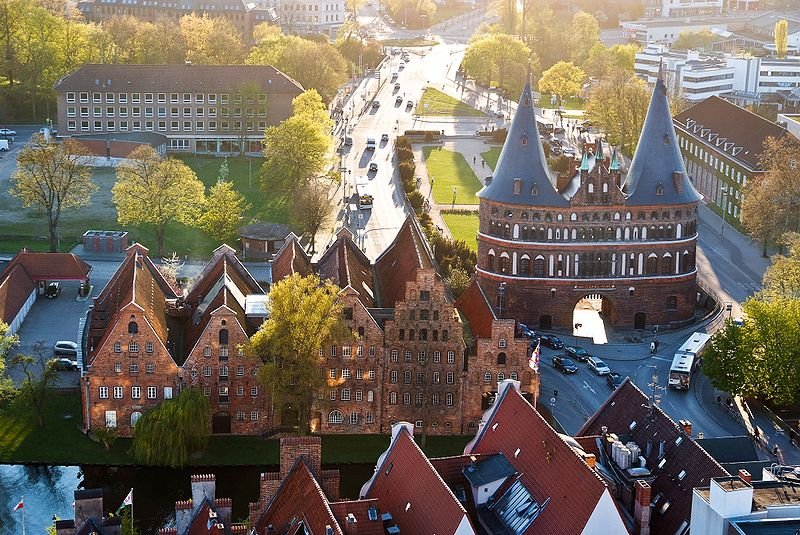 Lübeck, viewed from the tower of St Petri
Lübeck, viewed from the tower of St PetriSource: https://commons.wikimedia.org/wiki/File:View_over_L%C3%BCbeck_April_2009.jpg
Author: Arne List

Lübeck is the second biggest city in the state of Schleswig-Holstein in Germany. It covers 214.13 sq km (82.68 sq mi) and has a population of 210,000 (2011 estimate). The city is situated on the river Trave. It has the biggest port in Germany facing the Baltic Sea.
Lübeck is the former capital of the Hanseatic League. Today it has numerous buildings in the Brick Gothic architectural style. Lübeck's Old Town is today a World Heritage Site.
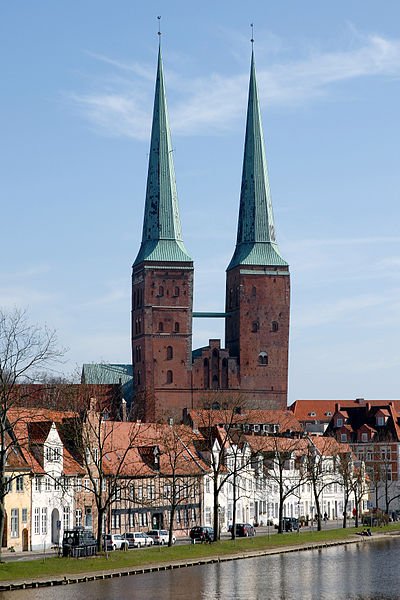 Lübeck Cathedral
Lübeck CathedralSource: https://commons.wikimedia.org/wiki/File:L%C3%BCbeck_Dom-von-Westen_070311.jpg
Author: Torsten Bolten

World Heritage Site Inscription Details
Location: N 53 52 0.012 E 10 41 30.012Inscription Year: 1987
Type of Site: Cultural
Inscription Criteria: IV Although the area around Holstein has been inhabited since as early as AD 700, the city itself was founded in the 12th century. By the 14th century, it became the "Queen of the Hanseatic League," being the biggest and most powerful member of the medieval trading organisation. Emperor Charles IV of the Holy Roman Empire called it the five "Glories of the Empire" along with Venice, Rome, Pisa and Florence.
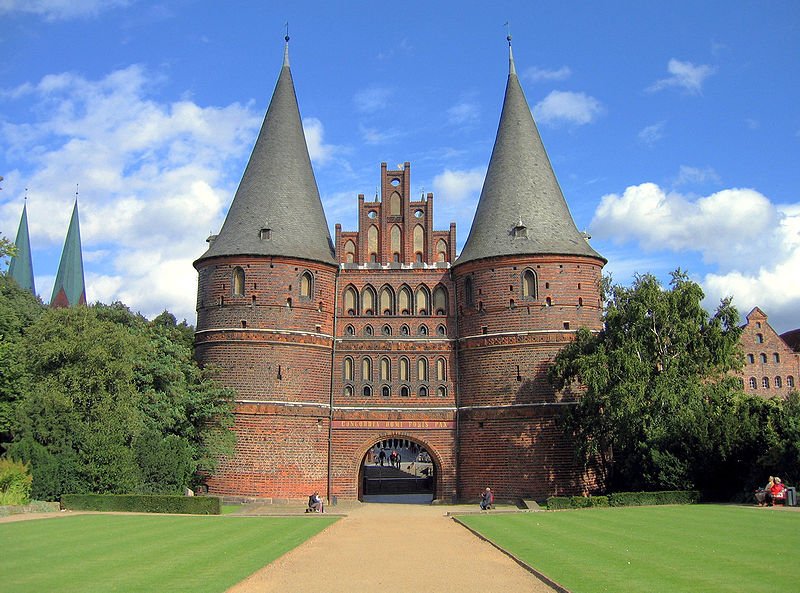 Holstentor, Lübeck
Holstentor, LübeckSource: https://commons.wikimedia.org/wiki/File:Holstentor04.jpg
Author: Glenn Strong

The Lübeck area has been settled since the Neolithic period. The town of Lübeck was founded in 1143 by Adolf II, Count of Schauenburg and Holstein. He built a castle there in 1147. However in 1158, Adolf had to cede his castle to Henry the Lion. Then Lübeck became an Imperial City within the Holy Roman Empire, ruled by Emperor Barbarossa. Lübeck continued to change hands in the 12th century. It was briefly controlled by the Duchy of Saxon until 1192. Then it became part of the County of Holstein until 1217. Following the Battle of Bornhöved in 1227, it was absorbed in Denmark.
Under the rule of Emperor Frederick II, Lübeck was elevated to Imperial Free City. It grew in power as the most important city of the Hanseatic League, and by the 14th century, earned the title of "Queen of the Hanseatic League". Lübeck was at the height of its power in the 15th century, when the Hanseatic League won a number of conflicts. However, by the 16th century, particularly after a civil war with Denmark from 1534 to 1536, its power began to decline.
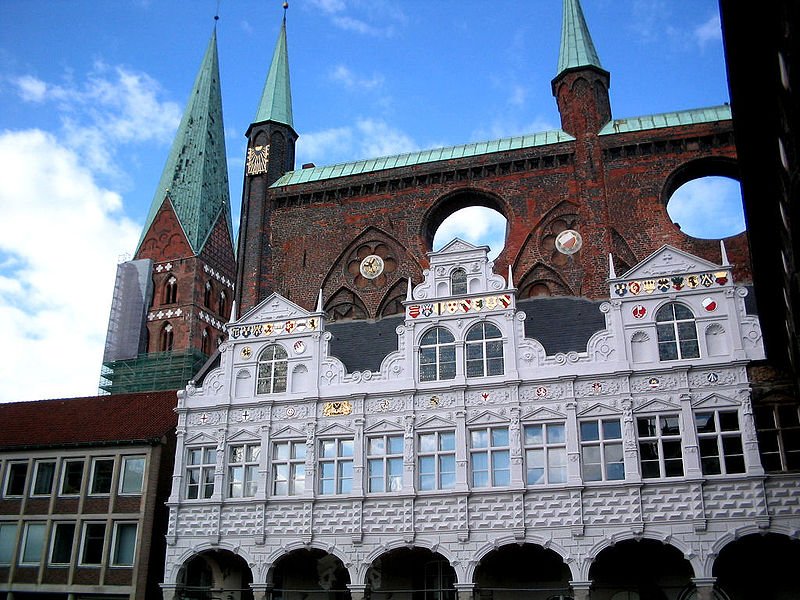 Lübeck town hall
Lübeck town hallSource: https://commons.wikimedia.org/wiki/File:Lubeck-townhall-detail.JPG
Author: Torstein Frogner

The power of Lübeck began to decline following its defeat in the Count's Feud (1534-36). Although it managed to remain neutral in the Thirty Years' War (1618-1648), by then trading orientation had move transatlantic, resulting in lesser influence and significance for the Hanseatic League. Eventually it was disbanded in 1669, although Lübeck remained an important trading port on the Baltic Sea.
Hanseatic City of Lübeck was inscribed as a World Heritage Site during the 11th session of the World Heritage Committee which met at the Headquarters in Paris, France on 7-11 December, 1987.
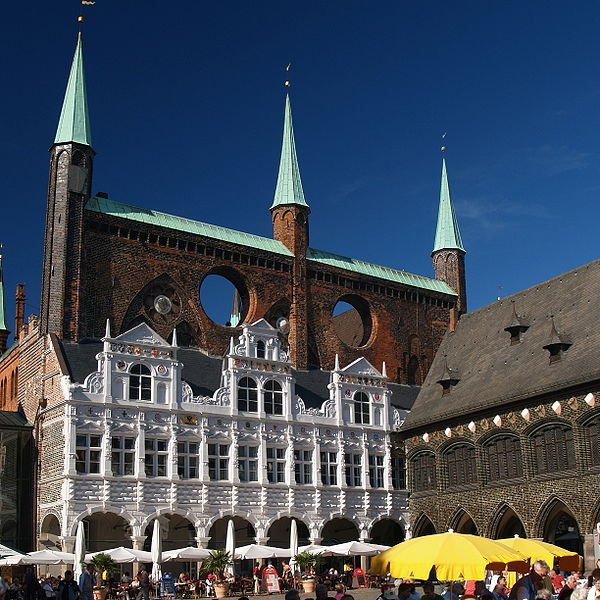 Lübeck Rathaus, the town hall of the city
Lübeck Rathaus, the town hall of the citySource: https://commons.wikimedia.org/wiki/File:Germany_Luebeck_townhall_Anbau.jpg
Author: Arnold Paul

The Hanseatic League was also losing power, and in 1669, it was disbanded. It found itself in such dire straits that between 1811 and 1813, it was annexed as part of France. In 1937, the Nazis expanded the territories of Hamburg to absorb the surrounding towns including Lübeck - Hitler had a personal dislike over the town because it refused to allow him to campaign there some years back.
More misfortune fell on Lübeck with the start of the Second World War. It was one of the first German cities to be bombed by Allied forces. Following the end of the war, Lübeck was under British occupation. Lübeck became part of West Germany following the Cold War. During that time, the river Wakenitz separated Lübeck from East Germany.
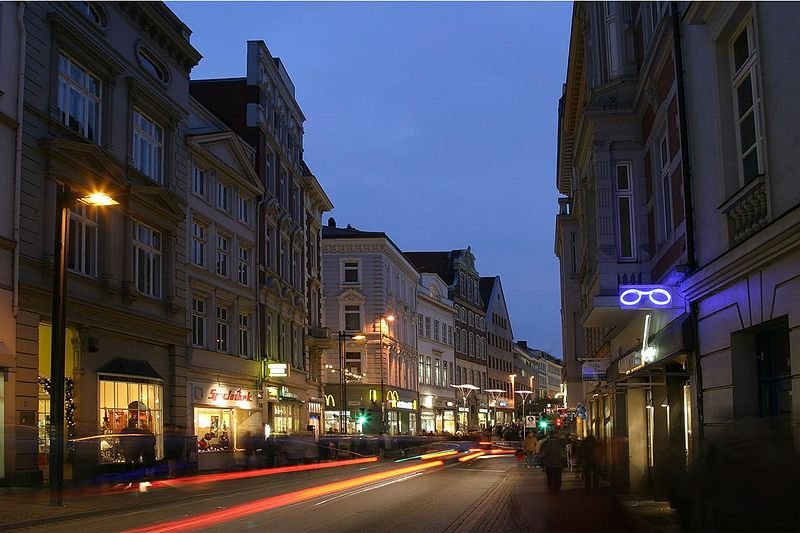 Breite Straße, between Fischergrube and Pfaffenstraße, Lübeck
Breite Straße, between Fischergrube and Pfaffenstraße, LübeckSource: https://commons.wikimedia.org/wiki/File:BreiteStrasseBetweenFischergrubeAndPfaffenstrLuebeck%28Germany%29.jpg
Author: Andreas Geick

Visiting Lübeck, Germany
Lübeck Airport (LBC) gets flights by Ryanair from London-Stansted. From the airport, you can take public bus number 6 to the Hauptbahnhof (main railway station). To go from the railway station to the airport, look for trains to Lübeck Flughafen.If you're coming by road from Hamburg, take Autobahn 1. From Kiel, take Autobahn 21 until Bad Segeberg-Nord, then continue on Route 206 (Bramstedter Landstraße) with connects to Autobahn 20 heading towards Lübeck.
Exploring Lübeck
The best way to explore Lübeck is to go on foot. The Old Town is quite compact with many of the historical buildings close to each other. If you have to travel greater distances, the city has a bus network as well as taxis.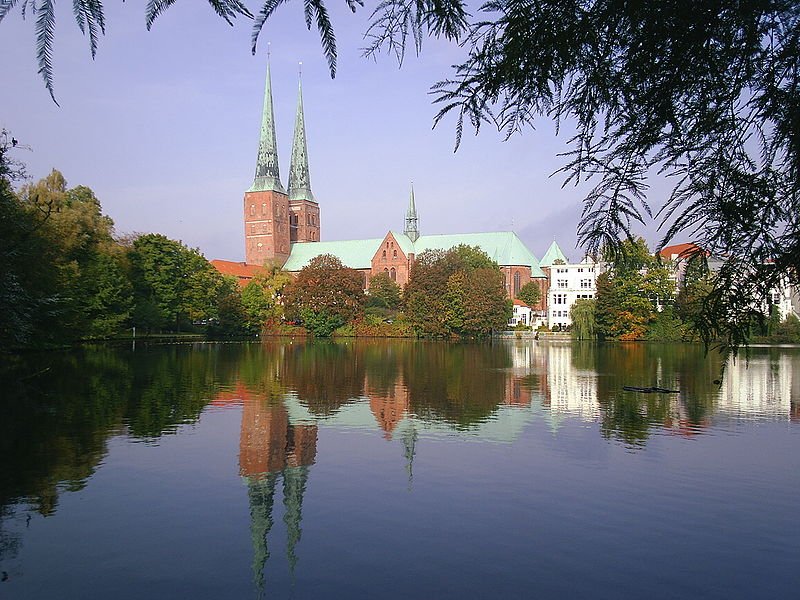 Lu¨beck Cathedral
Lu¨beck CathedralSource: https://commons.wikimedia.org/wiki/File:Dom_zu_L%C3%BCbeck.JPG
Author: Rüdiger Zielke
Places of Interest in Lübeck, Germany
- Buddenbroookhaus
This lovely house was once the home of Nobel Prize-winning author Thomas Mann. - Burgtor
Castle gate on the northern part of the town limits. - Dom
The Lübeck Cathedral, began in 1173 and completed in 1230. - Füchtigshof
An interesting courtyard, or Höfe, through charming, narrow streets, on the eastern part of Lübeck. - Haus der Schiffergesellschaft
House of the Marine Guild, dating to 1535, has a beautiful interior, today housing an elegant restaurant. - Heiliger-Geist-Hospital
The Holy Ghost Hospital, built in the shape of the letter T, is the best preserved medieval building of its kind in Central Europe. - Herz-Jesu-Kirche
19th century Catholic church with a memorial to four clergymen executed by the Nazis for their opposition to the war. - Holstentor
The icon of Lübeck, this gate was once the only entrance into the city. It was built in 1466-78, at the height of the city's glory. - Jacobikirche
15th century church with its beautiful Baroque features still well preserved and undamaged by World War II. - Katharinenkirche
St Catherine's Church is the only surviving monastic church by the Franciscans in Lübeck. - Kunsthalle St-Annen
Museum housed in a former Augustinian convent showcasing the lifestyle and culture from the 13th to the 18th century in Lübeck. - Marienkirche
The St Mary's Church is bigger than the cathedral. It is situated behind the town hall. - Petrikirche
The Church of St Peter is the only five-nave church in Lübeck. - Rathaus
The Lübeck Town House is also the most famous town house in Germany. It dates from 1226. - Schabbelhaus
One of the most interesting patrician houses in Mengstrasse is No. 48, built in 1558, with a magnificent Baroque hall added in the 18th century.
 Latest updates on Penang Travel Tips
Latest updates on Penang Travel Tips
 Discover with Timothy YouTube Channel
Discover with Timothy YouTube Channel
 PG Food Channel
PG Food Channel
 Learn Penang Hokkien YouTube Channel
Learn Penang Hokkien YouTube Channel
 SojiMart Videos
SojiMart Videos
Latest from Discover with Timothy: Gurney Bay - what to see and do there
About this website

Hello and thanks for reading this page. My name is Timothy and my hobby is in describing places so that I can share the information with the general public. My website has become the go to site for a lot of people including students, teachers, journalists, etc. whenever they seek information on places, particularly those in Malaysia and Singapore. I have been doing this since 5 January 2003, for over twenty years already. You can read about me at Discover Timothy. By now I have compiled information on thousands of places, mostly in Peninsular Malaysia and Singapore, and I continue to add more almost every day. My goal is to describe every street in every town in Malaysia and Singapore.
Robbie's Roadmap
- Episode 1: Robbie's Journey to Financial Freedom
- Episode 2: Lost in America
- Episode 3: The Value of Money
- Episode 4: The Mentor
- Episode 5: The Thing that Makes Money
- Episode 6: The walk with a Billionaire
- Episode 7: The Financial Freedom Awakening
- Episode 8: Meet Mr Washington
- Episode 9: The Pizzeria Incident
Copyright © 2003-2024 Timothy Tye. All Rights Reserved.


 Go Back
Go Back